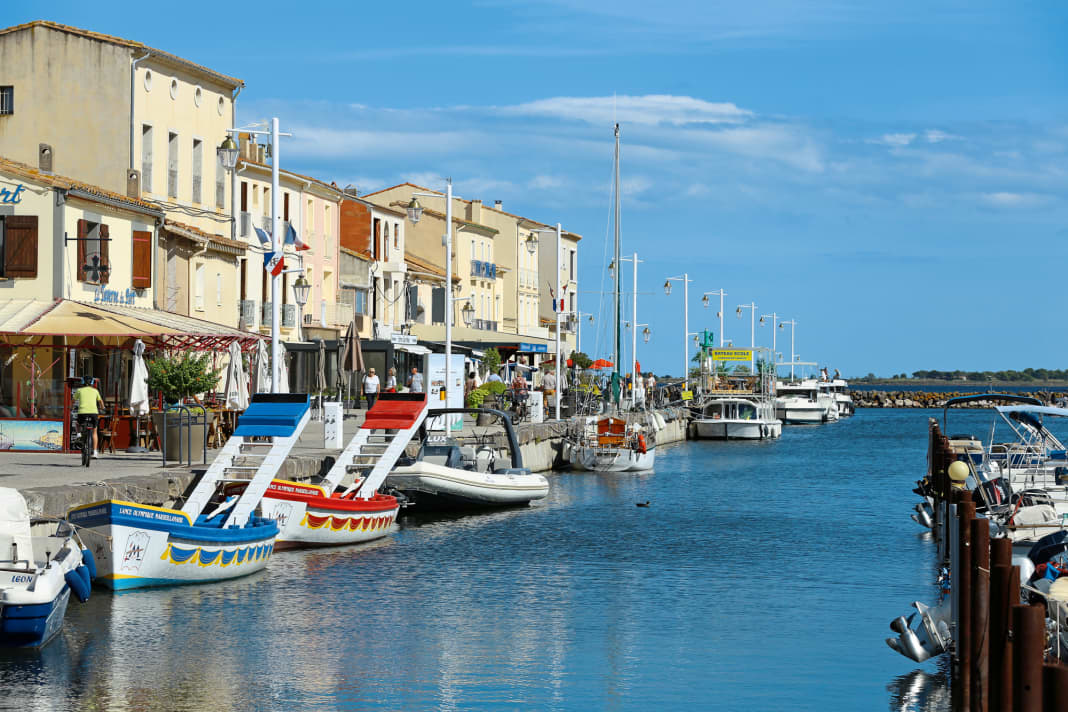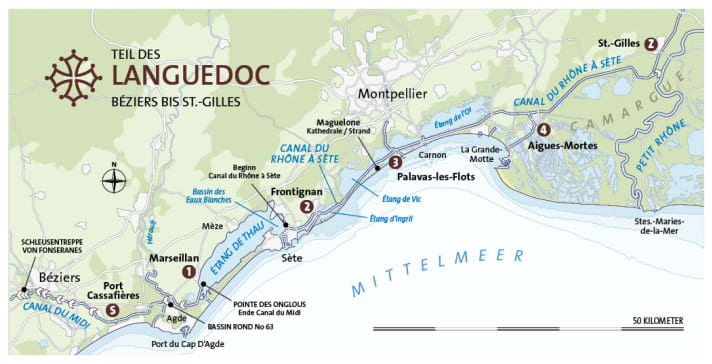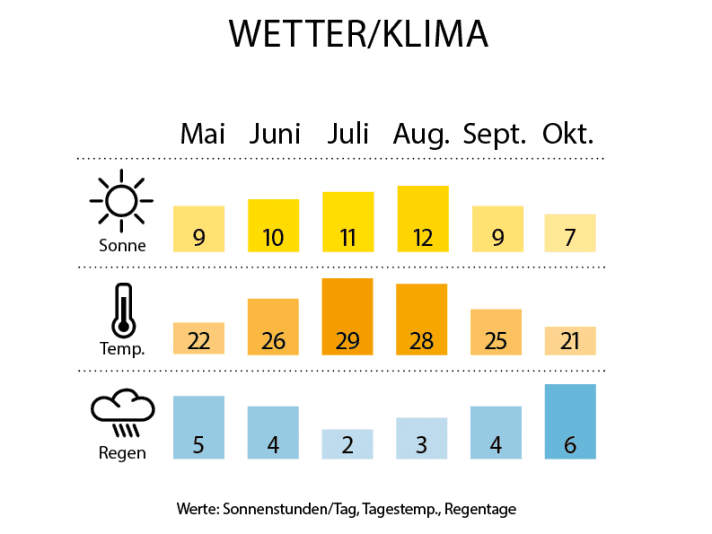South of France: The main road by the sea - the Canal du Midi and Canal du Rhône à Sète
Christian Tiedt
· 26.09.2024






One more run-up and then up with vigour! We start pedalling, but although the path is neither particularly steep nor the dune very high, the small wheels of our on-board bikes soon get stuck in the fine sand. No matter, we push the last few metres and then it's in front of us: Maguelone beach.
We were less than five minutes away from our mooring on the banks of the canal. Nowhere in Europe can you get closer to the Mediterranean with a licence-free charter boat than in the south of France. Even the Veneto lagoons can't compete with that. The Canal du Rhône à Sète follows the Languedoc coastline for around thirty kilometres, sometimes even within sight, past busy seaside resorts and more secluded stretches that are more popular with the locals. Like in Maguelone, the favourite bathing spot of the inland city of Montpellier. We lock the bikes together at a wooden post in the dune grass. René shoulders the parasol, I take the cool box. The sun is blazing and the calm water could hardly be more enticing. So off into the water!
The first kilometres of the canal, with their lush greenery, do not yet look at all like the sun-bleached south
Two days earlier, when we set off on our cruise, leave the harbour basin of Port Cassafières, home of Le Boat's charter base, and turn right with our Horizon, heading east, the first few kilometres don't really look like the sun-bleached south. With lush greenery on both sides and the foliage of overhanging trees, this section of the Canal du Midi at least reminds us of the waterways in Burgundy or Alsace, with low bridges and the odd seemingly abandoned boat on the banks, in various stages of unhurried decay. Incidentally, most charter crews are drawn here in the opposite direction, westwards, up the Canal du Midi towards Béziers and onwards to Carcassonne via the first lock staircase at Fonseranes.
Only stumps remain of the avenues along the Canal du Midi
The route there is as picturesque as it is famous, albeit with dozens of locks, and we are not at all unhappy that we are spared them this time. We have just two ahead of us, both today. However, we would still have liked to make the short detour to the medieval town of Béziers, once there and back, as a prelude. It wasn't the time that was the problem: a total of 28 kilometres and ten locks there and back would have been doable. The culprit was a thunderstorm, the likes of which we had never experienced before, from late morning until late at night, with weather lights flashing every second. But that was yesterday. The sky is still cloudy, but it should clear up. And we are on our way!
Twenty thousand Tonnes of the delicacy hang by a thread, so to speak, in the shallow waters of the Étang
After an hour and a half, we reach Agde, even though the canal passes the town to the north. The signal at the Bassin Rond, the basin lock with the serial number 63, is green and we can enter immediately. We moor at the round chamber wall, with a second Horizon behind us, and the éclusier The lock is set in motion via tablet. It goes down just under a metre without any problems. After the exit, there is a short stretch on the River Hérault, which crosses the canal before the last section of the Canal du Midi begins behind the open protective lock at Prades (No 64). Here you can now see the damage caused by the pest fungus that has almost completely destroyed the iconic plane tree avenues along the canal in recent years: A long row of tree stumps lines the bank, but it has already been resurfaced and planted with still very dainty new trees.
It's five to twelve when we reach the second (and last) lock of our trip, Bagnas (No 65). The keeper is just going into his house for his lunch break. No problem, we moor up, put the canopy up and finally get to have lunch. Our neighbours in the little packet, an elderly couple from Alsace, provide the entertainment. He is a retired bargeman, used to sail all over Europe and of course knows this area like the back of his hand. There is only one colleague still travelling on the canal with his péniche, he says in the German dialect of his home region, "no chance against the lorry".
The inland is now changing, becoming wider, flatter and drier. Large boulders have broken out of the loamy shore. We have reached sea level and the coast is right next door. The last section of the canal is even lined with fishing boats. Our "Guide Fluvial No 07" tells us that the lagoon beyond the dam on the starboard side already belongs to the Étang de Thau, the large inland lake that we want to cross tomorrow.
We really haven't had anything like this before: Mediterranean flair with a houseboat
At the Pointe des Onglous, we then see the unmistakable sign that the sea is not far away: a white lighthouse with a red lantern. The Canal du Midi ends at this pier head. Just one kilometre to the north-east across the open water, we can already see Marseillan, our destination for the day. The distance is quickly covered and there are still a few nice places available on the north side of the harbour. Soon we are alongside the wall. We really haven't had anything like this before: Mediterranean flair with a houseboat! Sunshine, light-coloured stone, tourists! The Capitainerie is still unoccupied, so we first take photos of the boat as proof of this unique moment. 46 euros are due later. But we've already paid considerably more for less.
Once into town to the supermarket on Place Géneral Guillaut (we're still short of washing-up liquid), we follow a recommendation to visit Noilly Prat - one of the most traditional and well-known producers of vermouth. The visit will live long in the memory, as the exciting tour is quite literally something: not only because it takes over 75 minutes through the sacred halls (and in between across the so-called forecourt of heaven), but also because a total of eight stations in the product creation process are tasted.
The witty pilgrimage leads past mighty Canadian barils (which a slight employee has to clean from the inside), past disdainful concrete tanks and old casks, that still smell of sherry and whiskey. They all have to do with the refining process: bottling, waiting, decanting, bottling - until the bottle is "decanted" over the glass and palate of the connoisseur. In the end, we realise that Marilyn Monroe, Ernest Hemingway and James Bond would not have become the same people without the special herbal recipes of Messieurs Noilly & Prat. And we also learn that a resolute lady resides in Monte Carlo (where else?) who actually bears the name Bacardi and rules a worldwide empire of high-proof spirits from the back of her Rolls-Royce... With the water level slightly higher, which will hopefully make groundings a little less likely in the next day, we stroll back to the boat, the blue sky above us.
Marilyn Monroe, Ernest Hemingway and James Bond would probably have become different people without the Messieurs
The wind blows lightly from the north-east the next morning, but is far from the 20 to maximum 25 kilometres per hour that is the permitted upper limit for crossing the Étang de Thau. A similar regulation to that on the Müritz, where charter boats are only allowed to sail up to wind force 4. As we don't have an echo sounder, the nautical chart gives no information and the "shortcut" in an easterly direction to the main fairway across the Étang is not buoyed, we play it safe: back to the Phare des Onglous, but then to the north-east.
It's just under 16 kilometres across the lagoon-like inland lake, which is around a two-hour journey for us. Nowhere else would you have more sea travel on a houseboat. The shore to the north is flat and dry, with gentle hills behind it. Far to the north, real mountain ranges with individual peaks can be recognised on the horizon. Google tells me that these must be the Cévennes, the southernmost foothills of the Massif Central. The narrow spit that separates us from the Mediterranean to starboard has almost no elevation profile. There are no flamingos to be seen, only seagulls. The sun beats down on the reflective surface of the water. Although it is the weekend, we are almost alone.
The seaport of Sète is the gateway to the canal
Soon we have the oyster farms on our port side, endless wooden frames with hanging lines. 20,000 tonnes of this delicacy are farmed here. The few pairs of buoys that mark the fairway are so far apart that you can't see them even with binoculars. The hotel and apartment complexes around Mont Saint Clair, the round local mountain of the town of Sète, come into view on starboard. Woods and villas can be seen.
On the short The spinnakers billow out of the wind
The fact that Sète is a seaport is also evident on the inland side: in the bay of Des Eaux Blanches, a regatta with larger yachts is underway around the Roquerols rocks. The spinnakers are billowing out on the short courses before the wind. The black and yellow cardinal beacons flanking the fairway are as massive as those on the coasts of Brittany. We leave the passage into the harbour with its mega yachts and tugs, which we are not allowed to enter because of the swing bridge in front of it, to the right and instead head for a small red and white beacon at the end of a worn concrete pier: the start of the Canal du Rhône à Sète.
The first few kilometres through the industrial area don't look inviting, with the usual long-term trailers, rusty warehouses and rubbish-strewn wire fences. Even in the sunshine. So on we go. The Étang de Thau and Sète are behind us, the canal now runs in straight sections with properly stabilised banks. Behind it on the left is a wetland, and on the right, where anglers and cyclists use the dusty accompanying road, a large petrol depot soon comes into view. In more industrial times there was an oil refinery here, we read later. It was closed in 1986. The jobs are gone, only the tanks remain. So we reach Frontignan, with its light-coloured stone houses and a new, really nice jetty in front of the ultra-modern lift bridge, with trees and benches along the promenade. This has already won over other crews, with five boats already moored here. We can also spot our lock neighbour from Alsace.
In a quiet way the past splendour of the Romanesque cathedral is visible again today
Registration at the tourist information centre is very friendly. We can even lie down for free and pay for the electricity at the machine next door. In the evening, we find ourselves in the Place Hôtel de Ville. There's a lot going on here, the whole town is on its feet. There's live music with the French cousins of Dire Straits in front of the chic town hall façade. We have the best view from a table at the Bar Central - great!
One lake after another is crossed
Over the next two days, the Canal du Rhône à Sète now not only runs in long, dead-straight sections in the immediate vicinity of the Mediterranean, it also crosses one étang after another. But no longer free, as it was yesterday, but flanked by solid embankments, some of which are no wider than dams. The separation from the sea is created by a narrow sandy spit. The Étang d'Ingril leads the way, followed by the much wider Étang de Vic. Flocks of flamingos can be seen in the distance like a shimmering mirage. The only obstacle on this section is the pedestrian pontoon bridge at Maguelone. It opens on demand as you approach.
But first we moor on the right bank for a longer stopover. Because we have two destinations: Firstly, we visit the Romanesque monastery cathedral of Saint-Pierre-et-Saint-Paul. Built on a hill covered in vines and surrounded by a forest of pines and cypresses, this extraordinary sacred building served as an episcopal church for a thousand years. After the title was transferred to nearby Montpellier in the 16th century, the complex fell into oblivion and fell into disrepair. It was only in modern times that it was "rediscovered" and after many years of restoration, the splendour of the past is once again quietly visible. For our second destination, we return to the beginning of the story - to Maguelone beach. We then spend the night unspectacularly and in complete peace and quiet less than four kilometres along the canal at the public jetty of the seaside resort of Palavas-les-Flots.
The next day we reach the foothills of the Camargue, the vast alluvial plain in the old delta of the Rhône. More and more reeds now cover the damp areas and the (sometimes more, sometimes less) wild white horses, to which the landscape has given its name, appear on the banks. At the old salt town of Aigues-Mortes, the last stop before reaching our destination harbour of Saint-Gilles, the Canal du Rhône à Sète finally bids farewell to the Mediterranean - and we bid it farewell. The last hint of its proximity is the tower high up on the battlements of the Tour de Constance, the massive cornerstone of the town fortifications: a lighthouse.
Service

Cruise stages
S Port Cassafières- Marseillan: 20 km
- Marseillan- Frontignan: 25 km
- Frontignan- Maguelone-Palavas-les-Flots: 17 km
- Palavas-les-Flots- Aigues-Mortes: 25 km
- Aigues-Mortes- St.-Gilles: 29 km
Z St.-Gilles
Total distance: 116 km
The TOP 3 in the district
- Marseillan Of all the small towns on the Étang de Thau (and in the entire region), it has the most Mediterranean charm - and with Noilly Prat, it also has a rich history.
- Maguelone The coolness inside the cathedral and the sun on the beach create a mix that should not be missed, even if you are travelling through without an overnight stay.
- Aigues-Mortes The medieval centre surrounded by its walls is worth seeing in itself. The Museum of Towers and Walls provides fascinating insights.
Literature
Water guide "Guide Fluvial 07: Canal du Midi". Also covers the waters east to the Rhône (Arles), including Étang de Thau and Canal du Rhône à Sète. Éditions du Breil; 1st edition (2022), 128 pages, A4 format, paperback, all information also in German; €20.50. ISBN: 2-913120-70-9. Order via www.hansenautic.de

Our boat: Horizon 1 (GRP displacement) - length: 11.50 m - width: 4.25 m - berths: 4 (2 double cabins) - WC/shower: 1/1 - special equipment: bow and stern thruster, second steering position (inside), gas grill, oven, air conditioning, flybridge with canopy. Price examples depending on season: € 3879 (start: 4.6.2023), € 2569 (start: 23.9.2023)
Charter: We travelled on a boat from Le Boat's Horizon series in the version with two double cabins (above). The company, which is represented in a total of eight European countries and Canada, also offers other boat types of different sizes and price ranges at this destination. Five bases are operated in the south of France, four of them on the Canal du Midi, including Port Cassafières, where our one-way trip began, and one on the Canal du Rhône à Sète, our destination harbour of St. Gilles.
Information: Le Boat, Theodor-Heuss-Str. 53-63, Eing. B, 61118 Bad Vilbel,Tel. 06101-557 91 75. www.leboat.de
Nautical information
The precinct
The holiday charter on the waterways described is licence-free, the navigation is for the most part completely unproblematic and can also be mastered by beginners without much stress. The only nautical exception is the Étang de Thau, which is actually classified as sea water. Within the designated fairways, however, it can also be navigated by inland vessels, including all charter boats in the area. However, when the wind picks up, a short, steep wave can build up within a short period of time due to the shallow depth, meaning that these boats are prohibited from navigating in winds of more than three Beaufort.
Another special feature is the Agde basin lock (No. 63 Bassin Rond). However, the lock staff have a good overview and will only initiate the lock when all the boats are safely moored against the unusual round chamber walls. Speaking of moorings: In addition to the harbours and public moorings (halte fluviale in French), there are also a number of natural moorings along the banks. However, they are not always suitable for overnight stays due to their location or the nature of the shore, and you will have to do without service anyway. In our opinion, the mooring at Palavas-les-Flots, on the right bank of the river Lez, is also unsuitable. The halte fluviale on the south bank of the canal immediately before the junction with the Lez is more suitable.

